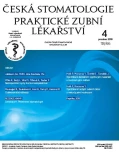All-Ceramic Reconstructions
Authors:
R. Mounajjed 1,2; H. Šoukalová 3; B. Azar 1; D. Černý 1,2; M. Hammal 1
Authors‘ workplace:
Klinika zubního lékařství LF UP a FN, Olomouc
1; Soukromá stomatologická klinika D. C. M., Hradec Králové
2; Centrum zubní péče, Jeseník
3
Published in:
Česká stomatologie / Praktické zubní lékařství, ročník 118, 2018, 4, s. 90-94
Category:
Review Article
Overview
Background:
Ceramics is a mixture of one or more metallic components with a non-metallic element, usually oxygen. The result is a chemically and biochemically stable substance that is hard, firm, brittle and thermally and electrically non-conductive. These properties are used in dentistry to produce dental ceramic restorations [14]. From all-ceramic or metalloceramic crowns and bridges, inlays, onlays, veneers and implants and their abutments, and teeth intended to use with the removable dentures [15].
Dental ceramics consist of a combination of amorphous glass (binder) and ceramic crystals (filler), whose relative ratio determines the final properties of the ceramic restorations [15].
Material properties:
The glass is a homogeneous amorphous (not a crystalline lattice) solid mass resulting from rapid cooling of the melt, most often glassy melting sand. Its main ingredient is silicon oxide (silica) SiO2, enriched with additives such as sodium carbonate (soda) and potassium carbonate to reduce melting temperature and calcium oxide (burnt lime) for better chemical resistance. By increasing the volume of amorphous glass, the ceramic structure gains transparency, but loses its mechanical resistance. The non-crystalline glass is etchable with hydrofluoric acid, allowing the subsequent adhesion of ceramic surface to hard tooth tissue [11, 15].
Conclusions:
Crystals (forming a crystalline grid) improve the mechanical properties of amorphous glass. They have the function of retarders to prevent cracks propagation and breakage of parts of ceramics. By increasing the binder and filler ratio in favor of crystals, ceramics loses transparency and becomes more resistant [11].
The all-ceramic restorations are very popular in everyday dental practice. It is a very reliable material that has a high aesthetic potential and a favorable mechanical resistance. Its good prognosis, while adhering to the right technological process, opens up other options for its use.
Keywords:
all-ceramic reconstructions – dental ceramics – feldspathic ceramics – lithium disilicate ceramic – Y-TZP ceramic
Sources
1. Blatz, M. B., Vonderheide, M., Conejo, J.: The effect of resin bonding on long-term success of high-strength ceramics. J. Dent. Res., roč. 97, 2018, č. 2, s. 132–139.
2. Bonaa, A. D., Shenb, C., Anusaviceb, K. J.: Work of adhesion of resin on treated lithia disilicate-based ceramic. Dent. Materials, roč. 20, 2004, s. 338–344.
3. CEREC Zirconia Processing Instructions: Restoration production for crowns and bridges. Sirona The Dental Company, manuals.sirona.com
4. Denry, I., Kelly, J. R.: State od the art of zirconia for dental applications. Dent. Materials, roč. 24, 2008, s. 299–307.
5. El-Damanhourya, H. M., Gaintantzopoulouc, M. D.: Self-etching ceramic primer versus hydrofluoric acid etching, Etching efficacy and bonding performance. J. Prosthodont. Res., 2017, s. 411–420.
6. Ferracane, J. L., Stansbury, J. W., Burke, F. J. T.: Self-adhesive resin cements – chemistry, properties and clinical considerations. J. Oral Rehabilitation, roč. 38, 2011, s. 295–314.
7. Guess, P., Schultheis, S., Wolkewitz, M., Zhang, Y., Strub, J. R.: Influence of preparation design and ceramic thicknesses on fracture resistance and failure modes of premolar partial coverage restorations. J. Prosthet. Dentistry, roč. 110, 2013, č. 4, s. 264–273.
8. IPS e.max Press Monolythic solutions: Instructions for use, Ivoclar Vivadent, www.ivoclarvivadent.com
9. Kalavacharla, V. K., Lawson, N. C., Ramp, L. C., Burgess, J. O.: Influence of Etching Protocol and silane treatment with a universal adhesive on lithium disilicate bond strength. Operative Dent., roč. 40, 2015, 4, s. 372–378.
10. Kelly, J. R., Nishimura, I., Campbell, S. D.: Ceramics in dentistry: historical roots and current perspectives. J. Prosthet. Dent., roč. 75, 1996, č. 1, s. 18–32.
11. Mounajjed, R.: Materiálová problematika suprakonstrukcí. ln: Šimůnek, A., a kol. Dentální implantologie, třetí, přepracované a doplněné vydání. Hradec Králové, Artilis, 2017, s. 213–222.
12. Mounajjed, R., Salinas, T. J., Ingr, T., Azar, B.: Effect of different resin luting cements on the marginal fit of lithium disilicate pressed crowns. J. Prosthet. Dent., roč. 2017.
13. Rinke, S.: Fixace celokeramických náhrad. ln: Rinke, S. Celokeramické náhrady, koncept pro praxi, 1. vyd. Praha, Quintssenz, 2014, s. 15–20.
14. The Glossary of Prosthodontic Terms: Ninth Ed. J. Prosthet. Dent., roč. 2017, č. 117, s. e20.
15. Zhang, Y., Kelly, J. R.: Dental ceramics for restoration and metal veneering. Dent. Clin. North Am., roč. 61, 2017, s. 797–819.
16. Zhang, Y., Lawn, B. R.: Novel zirconia materials in dentistry. J. Dent. Res., roč. 97, 2017, č. 2, s. 140–147.
Labels
Maxillofacial surgery Orthodontics Dental medicineArticle was published in
Czech Dental Journal

2018 Issue 4
- What Effect Can Be Expected from Limosilactobacillus reuteri in Mucositis and Peri-Implantitis?
- The Importance of Limosilactobacillus reuteri in Administration to Diabetics with Gingivitis
Most read in this issue
- All-Ceramic Reconstructions
- Wear of Hard Dental Tissues and Methods of its Evaluation
- Misdiagnosis of Nasopalatine Duct Cyst
- Wear of Dental Filling Materials and Possibilities of its Measurement
